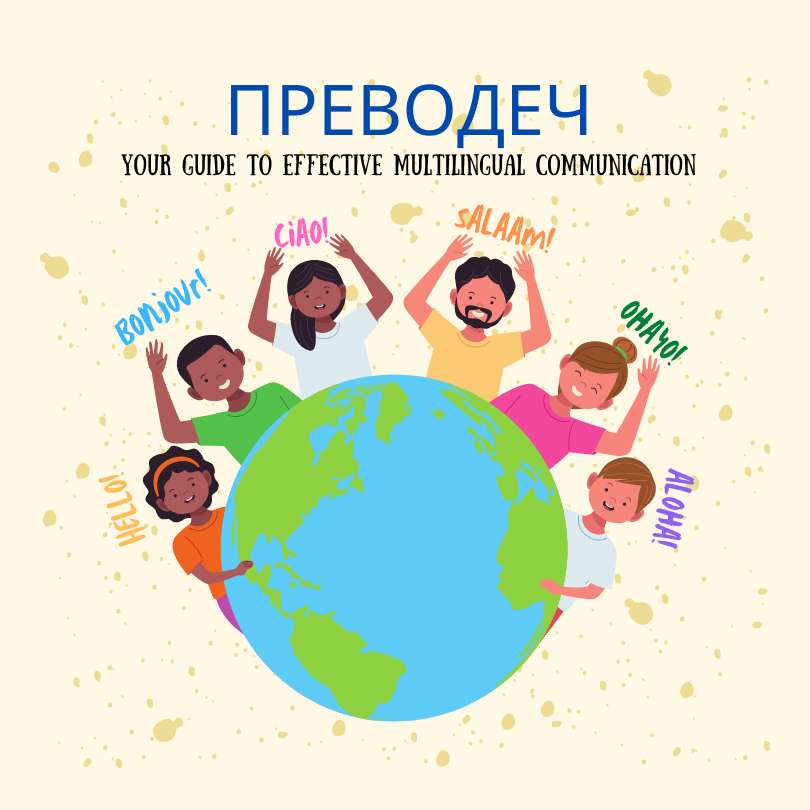преводеч: Your Guide to Effective Multilingual Communication

преводеч
Table Of Contents
What is a преводеч (translator)?
A преводеч (translator) is a skilled individual or tool who bridges the gap between languages by accurately and effectively conveying the meaning of written or spoken content from one language to another. Translators play a crucial role in facilitating communication and understanding across cultures, languages, and borders.
The growing importance of translation in today’s interconnected world:
In our increasingly globalized world, the need for effective translation has never been greater. As international trade, travel, and communication flourish, the ability to bridge language barriers becomes essential for success. Here are some key factors driving the demand for translation services:
- Globalization of Businesses: Companies are expanding their reach into international markets, necessitating the translation of marketing materials, websites, and legal documents to cater to diverse audiences.
- Rise of E-commerce: Online shopping transcends geographic boundaries, requiring product descriptions, customer support, and other content to be translated for a global audience.
- Multilingual Workforce: Businesses increasingly employ individuals from various countries, necessitating translation services for internal communication, training materials, and employee onboarding.
- Accessibility and Information Sharing: The proliferation of online content necessitates translation to ensure information accessibility for a wider audience, fostering knowledge sharing and cultural exchange.
Benefits of using translation services
Investing in professional translation services offers a multitude of advantages for individuals and businesses alike. Here’s a closer look at how specific user groups can benefit:
- Individuals:
- Travelers: Imagine navigating a bustling foreign market with confidence, thanks to accurate translations of menus, signs, and travel brochures.
- Students: Struggling with a complex academic paper? Professional translation can help unlock the meaning of foreign language research materials.
- Job seekers: Expand your career opportunities by presenting a professionally translated resume and cover letter to international employers.
- Businesses:
- E-commerce companies: Reach a global audience by translating product descriptions, customer support information, and marketing materials for diverse customer bases.
- Hospitality industry: Cater to international travelers with translated signage, menus, and guest information materials, creating a welcoming and inclusive experience.
- Legal and medical institutions: Ensure accurate communication with clients and patients by using professional translation services for critical documents and consultations.
By leveraging the expertise of skilled translators, you can unlock the potential of multilingual communication and achieve your specific goals in today’s interconnected world.
the potential of multilingual communication and navigate the globalized world with confidence.
Types of преводечи (Translators)
In today’s multilingual world, choosing the right преводеч (translator) for your needs is crucial. Understanding the different types of translators available and their respective strengths and limitations empowers you to make informed decisions.
Human Translators
Human translators are individuals with exceptional language skills, cultural knowledge, and subject-matter expertise who meticulously translate content from one language to another. They offer several distinct advantages:
- Accuracy and Nuance: Human translators possess a deep understanding of both languages, enabling them to capture the subtleties, idioms, and nuances that machine translation tools often miss. They can ensure the translated text accurately reflects the intended meaning and tone of the original content.
- Cultural Sensitivity: Skilled human translators are attuned to the cultural context and sensitivities of both source and target languages. They can adapt the translation to resonate with the target audience, avoiding cultural faux pas and ensuring effective communication.
- Creativity and Adaptability: Human translators can exercise their judgment and creativity when faced with challenges like puns, metaphors, or culturally specific references. They can adapt the translation to maintain the original message’s impact and flow within the target language.
When to Use Human Translators:
Human translation is the preferred choice for projects requiring:
- High Accuracy and Quality: This includes legal documents, financial reports, medical transcripts, and marketing materials where even minor errors can have significant consequences.
- Cultural Sensitivity and Nuance: Content intended for specific cultural contexts, such as advertising campaigns, literary works, or educational materials, benefits from the human touch to ensure appropriate cultural adaptation.
- Complex Subject Matter: Technical translations involving specialized terminology or intricate concepts require the expertise of human translators with relevant domain knowledge.
Machine Translation Tools
Machine translation (MT) tools are software programs that automatically translate text from one language to another. They offer several advantages:
- Speed and Convenience: MT tools can translate large volumes of text quickly and efficiently, saving time and resources compared to human translation.
- Affordability: MT tools are generally more cost-effective than human translation, making them suitable for budget-conscious projects.
- Accessibility: Many MT tools are readily available online or integrated into various applications, offering convenient access to translation services.
Limitations of Machine Translation:
Despite their convenience, MT tools have limitations:
- Accuracy and Fluency: While accuracy has improved significantly, MT tools can still produce errors, particularly with complex sentence structures, idiomatic expressions, and nuanced language. The resulting translations may lack fluency and sound unnatural.
- Cultural Context: MT tools often struggle to understand the cultural context of the source language, leading to translations that may be insensitive or inappropriate for the target audience.
- Limited Creativity and Adaptability: MT tools lack the human ability to adapt to specific contexts, translate creatively, or address challenges like puns or cultural references.
When to Use Machine Translation:
MT tools are suitable for:
- Simple Tasks: For quick understanding of the general meaning of short texts, such as news articles or social media posts, MT can provide a basic gist.
- Personal Use: When translating personal content for non-critical purposes, MT can be a convenient and cost-effective option.
- Getting the Gist of Content: If you need a general understanding of a text in another language but don’t require high accuracy or fluency, MT can provide a starting point.
The ideal choice between human and machine translation depends on your specific needs and priorities. Consider factors like project complexity, required accuracy, budget constraints, and target audience cultural sensitivity when making your decision. By understanding the strengths and limitations of both types of translators, you can select the most suitable option for your project, ensuring effective communication across languages.
Choosing the Right преводеч (Translator)
Selecting the right преводеч (translator) is crucial for ensuring the success of your multilingual communication endeavors. With a plethora of options available, navigating the choices can be overwhelming. This guide empowers you to make informed decisions by outlining key factors to consider and providing valuable tips for finding a reputable translator.
Factors to Consider
Choosing the right translator hinges on several crucial aspects:
- Language Pair and Expertise: Ensure the translator possesses native-level fluency in both the source and target languages. Additionally, consider their expertise in specific language variations or dialects relevant to your project.
- Subject Matter Specialization: For specialized content like legal documents, medical reports, or technical manuals, opt for translators with demonstrable experience and knowledge in the relevant field. This ensures accurate terminology usage and nuanced understanding of the subject matter.
- Experience and Qualifications: Seek translators with a proven track record of success in handling similar projects. Look for relevant certifications, professional memberships, or academic qualifications that demonstrate their expertise.
- Cost and Turnaround Time: Compare pricing models offered by different translators, considering factors like word count, project complexity, and urgency. Determine the acceptable turnaround time and ensure the translator can meet your deadlines.
- Reviews and Recommendations: Leverage online reviews, testimonials from previous clients, or recommendations from trusted sources to gain insights into the translator’s quality of work, professionalism, and communication style.
Tips for Finding a Reputable преводеч (Translator)
Finding a reliable translator requires exploring various avenues:
- Online Directories and Freelance Platforms: Numerous online platforms connect businesses and individuals with freelance translators. Utilize filters to search for translators based on language pairs, expertise, and budget. Carefully review their profiles, qualifications, and client feedback before making a selection.
- Professional Translation Agencies: Partnering with established translation agencies provides access to a pool of vetted and experienced translators. Agencies often handle project management, quality assurance, and additional services, offering a comprehensive solution.
- Word-of-Mouth Recommendations: Seek recommendations from colleagues, industry contacts, or individuals who have previously used translation services. Personal recommendations can be a valuable source for finding reliable and trustworthy translators.
Remember: Communication is key. Discuss your project requirements, expectations, and budget with potential translators before making a final decision. Ask questions, assess their responsiveness, and ensure they understand your specific needs.
By carefully considering these factors and utilizing the provided tips, you can confidently choose the right преводеч (translator) to bridge the language gap and achieve effective communication in today’s interconnected world.
Effective Use of преводечи (Translators)
Maximizing the benefits of your chosen преводеч (translator) requires effective collaboration and preparation. This section empowers you to optimize the translation process, ensuring successful communication across languages.
Preparing Your Materials for Translation
Laying the groundwork for successful translation begins with meticulous preparation of your materials:
- Providing Clear Instructions and Context: Clearly outline your project goals, target audience, and desired tone of voice. Share any relevant background information, glossaries, or style guides that can aid the translator’s understanding.
- Formatting Your Content for Easy Translation: Ensure your content is well-formatted, organized, and free of errors. Consistent formatting simplifies the translation process and reduces potential inaccuracies.
- Proofreading Your Materials Before Submission: Carefully proofread your content for typos, grammatical errors, and inconsistencies. Submitting error-free materials minimizes the need for revisions and streamlines the translation process.
Working with Your преводеч (Translator)
Effective communication and collaboration are essential for achieving optimal results:
- Clear Communication and Expectations: Establish clear communication channels and set realistic expectations regarding deadlines, budget, and revision cycles. Discuss any specific requirements or preferences you may have.
- Providing Feedback and Revisions: Offer constructive feedback on the initial translation, focusing on areas that require clarification or improvement. Be specific and provide clear instructions for revisions.
- Building a Long-Term Relationship: Consider establishing a long-term relationship with a trusted translator for ongoing projects. This fosters familiarity with your specific needs and terminology, leading to improved efficiency and consistency in future translations.
Additional Tips:
- Leverage translation memory tools to store previously translated phrases and terminology, ensuring consistency across projects.
- Utilize glossary creation tools to define key terms and ensure consistent translation throughout the content.
- Maintain open communication and ask questions if anything is unclear. Effective communication fosters collaboration and a successful translation outcome.
By following these guidelines and fostering a collaborative approach, you can harness the expertise of your chosen преводеч (translator) to achieve seamless communication and bridge language barriers effectively.
The Future of преводечи (Translators): A Dynamic Landscape of Collaboration
The world of translation is undergoing a continuous evolution, driven by advancements in technology and the ever-growing need for seamless communication across languages. This section explores the future of преводечи (translators), highlighting the interplay between machine translation and human expertise.
Advancements in Machine Translation Technology
Machine translation (MT) technology is rapidly advancing, fueled by developments in artificial intelligence and big data. These advancements offer several promising possibilities:
- Enhanced Accuracy and Fluency: As algorithms learn from vast amounts of translated data, MT accuracy and fluency are steadily improving, particularly for common languages and straightforward content.
- Increased Efficiency and Speed: MT tools can translate large volumes of text quickly and efficiently, potentially reducing costs and turnaround times for specific projects.
- Accessibility and Language Diversification: MT tools are becoming more readily available and user-friendly, potentially democratizing access to translation services for diverse languages.
The Continued Need for Human Expertise
Despite the progress in MT, human translators remain irreplaceable for several crucial reasons:
- Cultural Sensitivity and Nuance: Capturing the subtle nuances, cultural references, and idiomatic expressions that define effective communication requires human understanding and judgment.
- Complex Subject Matter Expertise: Specialized content like legal documents, medical reports, or technical materials demands translators with deep domain knowledge to ensure accurate terminology and conceptual understanding.
- Creative Adaptation and Judgment: Human translators excel at adapting content to specific audiences and contexts, employing creativity and judgment to navigate challenges like puns, metaphors, and cultural references.
The Evolving Role of the преводеч (Translator) in a Multilingual World
The future of translation envisions a collaborative environment where MT and human expertise complement each other:
- Human-in-the-Loop MT: Skilled translators will oversee and refine machine-generated translations, ensuring accuracy, cultural sensitivity, and adherence to specific project requirements.
- Focus on Value-Added Services: Translators will increasingly offer specialized services like transcreation, localization, and content editing, leveraging their expertise to deliver tailored solutions for diverse communication needs.
- Technology-Assisted Workflows: Translators will utilize advanced tools like translation memory software and terminology management systems to streamline workflows, improve efficiency, and maintain consistency across projects.
The future of the преводеч (translator) is not one of obsolescence but rather of adaptation and evolution. As technology continues to develop, human translators will remain essential for navigating the complexities of language, ensuring effective communication, and fostering cross-cultural understanding in an increasingly interconnected world.
Conclusion
The Value of Effective Translation in Communication and Understanding
In today’s globalized world, effective translation serves as a bridge that connects individuals, cultures, and businesses across diverse languages. By enabling seamless communication and fostering understanding, преводечи (translators) play a vital role in:
- Breaking down language barriers: Translations empower individuals to access information, engage in meaningful conversations, and participate in global opportunities regardless of their native language.
- Promoting cultural exchange: Accurate and culturally sensitive translations facilitate the exchange of ideas, knowledge, and perspectives, fostering mutual understanding and appreciation between different cultures.
- Expanding business reach: Businesses leverage translation services to reach wider audiences, navigate international markets, and build stronger relationships with global partners and customers.
- Ensuring accurate and reliable information: Precise translations guarantee the integrity of information across languages, preventing misunderstandings and promoting informed decision-making in various fields.
Investing in professional translation services offers invaluable benefits, contributing to a more inclusive, interconnected, and informed world.
Share Your Experiences with Using преводечи (Translators)
Have you utilized the expertise of a преводеч (translator) in your personal or professional life? We encourage you to share your experiences in the comments below. Did translation services help you overcome a language barrier, connect with new cultures, or expand your business reach?
By sharing your stories, you can contribute valuable insights and empower others to leverage the power of translation in their endeavors.
Remember: The successful use of преводечи (translators) hinges on effective communication, collaboration, and a mutual understanding of project goals and expectations. By following the guidelines outlined in this comprehensive guide, you can harness the expertise of translators and navigate the world of multilingual communication with confidence.







